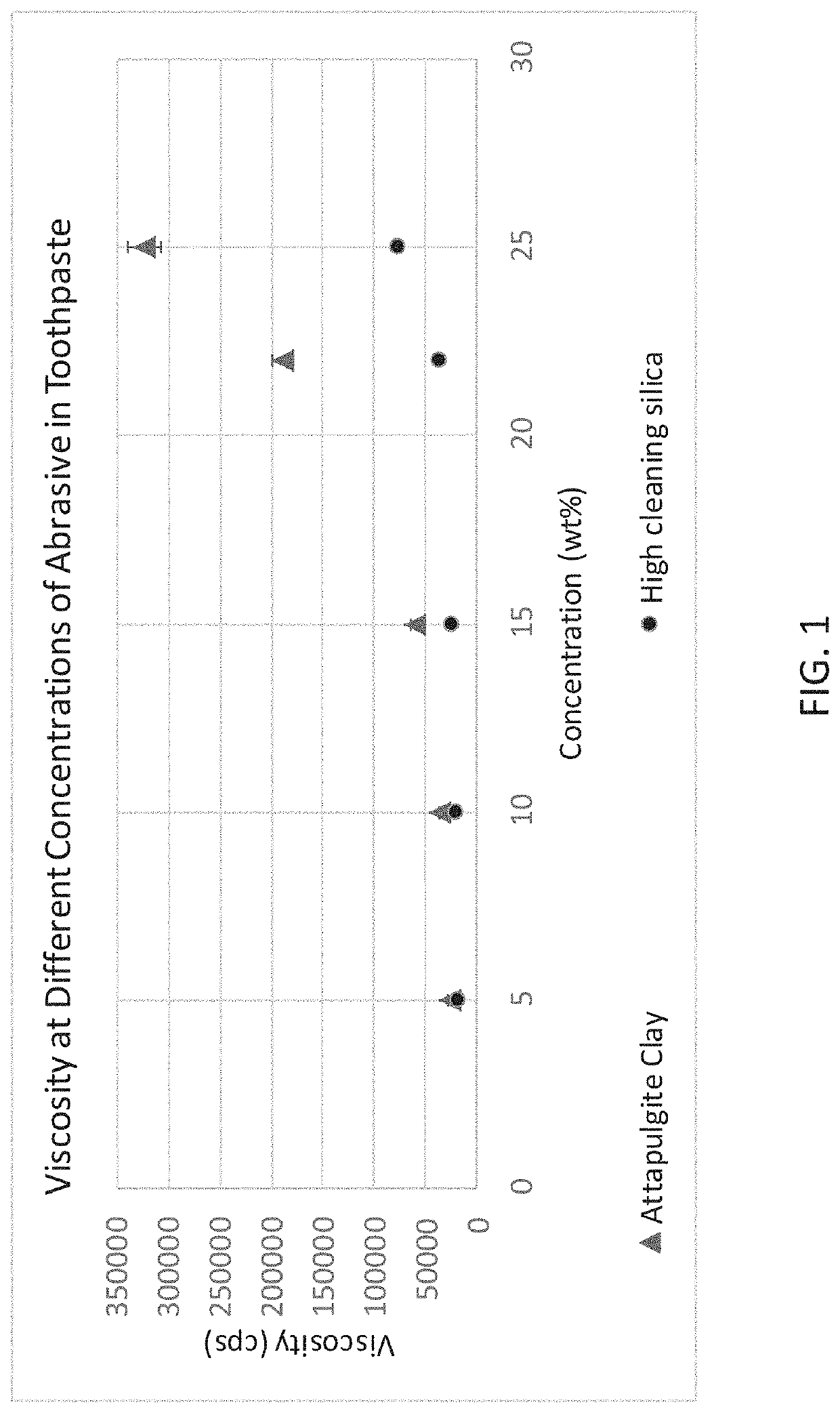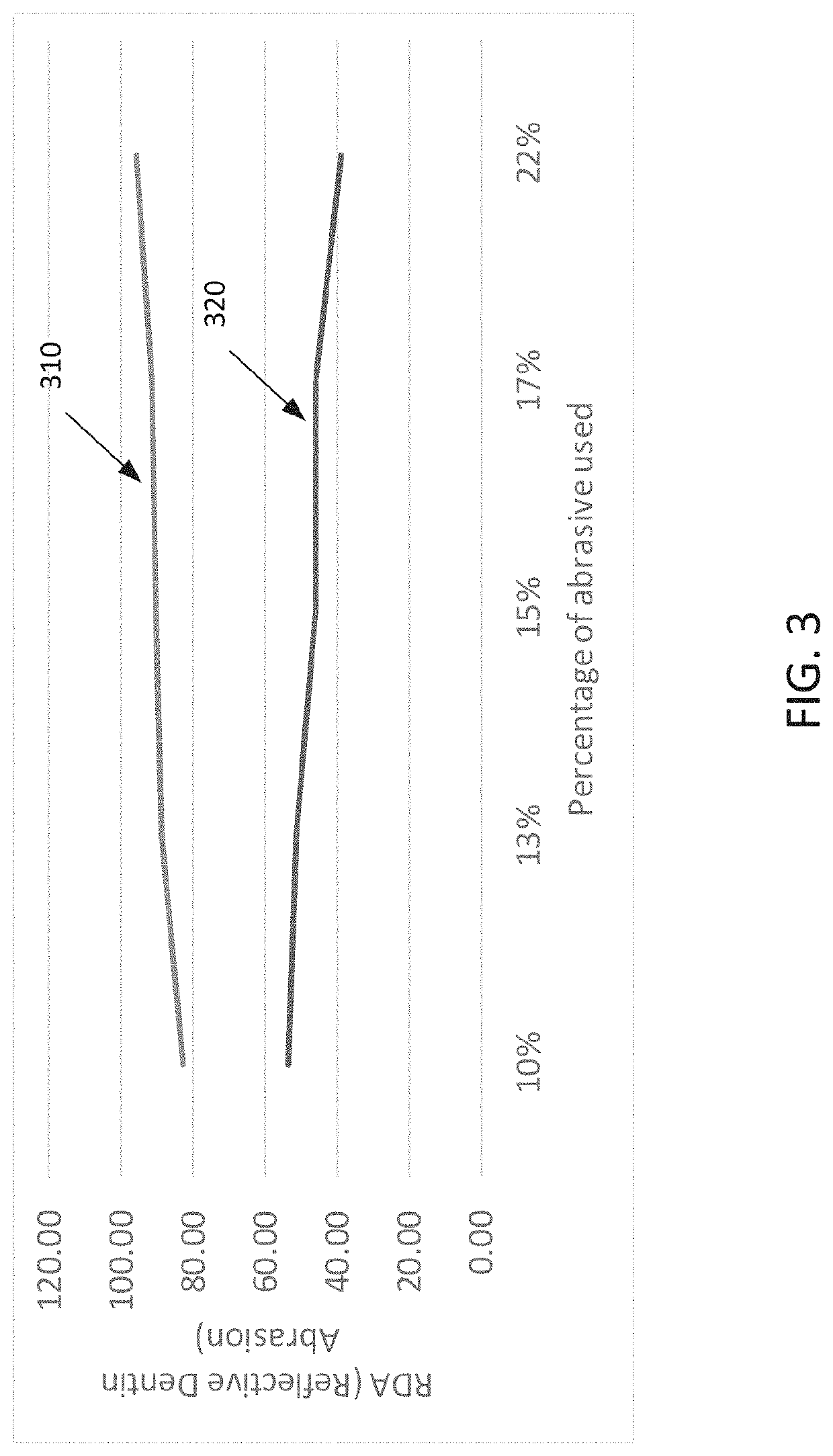Oral care composition
a technology of oral care and composition, applied in the field of oral care composition, can solve the problems of reducing the effect of silica on the surface of enamel, reducing the effect of silica on the effect of reducing the risk of tooth eroded, and only being able to deliver both benefits
- Summary
- Abstract
- Description
- Claims
- Application Information
AI Technical Summary
Benefits of technology
Problems solved by technology
Method used
Image
Examples
example 1
Compositions
[0074]In this example, five oral care compositions were prepared as summarized in Table 1 below. Oral care compositions 1 through 5 were prepared by mixing the ingredients listed under phase A, while avoiding incorporation of air. Separately, xanthan gum and carrageenan binders from the ingredients of phase B were dispersed in the remaining components of phase B. Phase B mixture was added into phase A mixture and the combined mixture was homogenized. Separately, the polyglycoside and poloxamer surfactants from the ingredients of phase C were dissolved in water. The homogenized mixture of the phase A and phase B ingredients was finally added into the phase C mixture and this final mixture was carefully homogenized.
TABLE 1Comp.Comp.Comp.Comp.Comp.1 (%2 (%3 (%4 (%5 (%PhaseIngredientsFunctionby wt)by wt)by wt)by wt)by wt)AWaterSolvent11.4310.639.738.437.9Sodium HydroxidepH adjustor0.30.30.30.30.3GlycerinSolvent1412.612.612.612.6SorbitolSolvent50.547.743.637.935.43Puricolor B...
example 2
Data
[0075]The viscosity at different concentrations of abrasive compound was tested. The abrasive compounds that were tested are attapulgite clay and high cleaning silica. The concentration that were tested are 5 wt %, 10 wt %, 15 wt %, 22 wt %, and 25 wt %, with the wt % being based on a total weight of the sample that was tested. The samples were prepared as described in Example 1 above.
[0076]The viscosity was measured with a Brookfield viscometer from Brookfield Engineering Laboratories Inc, with a T-bar spindle (F code 96) at 10 RPM on freshly prepared dentrifices and after three days of preparation (“after +3 days”). The results are summarized in Table 2 below and are depicted in FIG. 1 in a viscosity as a function of abrasive concentration plot. Each data point in the plot of FIG. 1 represents an average (the bars represent a standard deviation) obtained from three viscosity measurements for a particular sample (i.e., three viscosity measurements for each abrasive tested at ea...
example 3
Cleaning Ratio (PCR) Data
[0078]In this example, the PCR values of samples comprising attapulgite clay and high cleaning silica were obtained. The values are summarized in Table 4 below and depicted in FIG. 2.
[0079]For the PCR study, three samples were analyzed: 1) an American Dental Association (ADA) reference material, 2) a general abrasive (i.e., attapulgite clay), and 3) a reference abrasive (i.e., high cleaning silica).
PCR Study—Specimen Preparation
[0080]Bovine, permanent, central incisors were cut to obtain labial enamel specimens approximately 9×9 mm2 in size. The enamel specimens were then embedded in an auto polymerizing methacrylate resin so that only the enamel surfaces were exposed. The enamel surfaces were then smoothed on a lapidary wheel and polished with flour of pumice and water. Subsequently, the surfaces were sonicated to remove excess debris. The surfaces were then lightly etched (60 seconds in 0.12M HCl [10 ml of 37% / L], 30 seconds in saturated NaCO3 and 60 secon...
PUM
 Login to View More
Login to View More Abstract
Description
Claims
Application Information
 Login to View More
Login to View More - R&D
- Intellectual Property
- Life Sciences
- Materials
- Tech Scout
- Unparalleled Data Quality
- Higher Quality Content
- 60% Fewer Hallucinations
Browse by: Latest US Patents, China's latest patents, Technical Efficacy Thesaurus, Application Domain, Technology Topic, Popular Technical Reports.
© 2025 PatSnap. All rights reserved.Legal|Privacy policy|Modern Slavery Act Transparency Statement|Sitemap|About US| Contact US: help@patsnap.com



